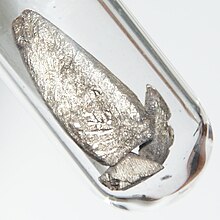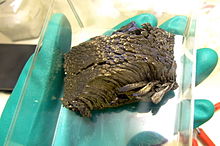Europium
 | |||||||||||||||||||||||||||||||||||||||||||
| Europium | |||||||||||||||||||||||||||||||||||||||||||
|---|---|---|---|---|---|---|---|---|---|---|---|---|---|---|---|---|---|---|---|---|---|---|---|---|---|---|---|---|---|---|---|---|---|---|---|---|---|---|---|---|---|---|---|
| Pronunciation | /jʊˈroʊpiəm/ | ||||||||||||||||||||||||||||||||||||||||||
| Appearance | silvery white, with a pale yellow tint;[1] but rarely seen without oxide discoloration | ||||||||||||||||||||||||||||||||||||||||||
| Standard atomic weight Ar°(Eu) | |||||||||||||||||||||||||||||||||||||||||||
| Europium in the periodic table | |||||||||||||||||||||||||||||||||||||||||||
| |||||||||||||||||||||||||||||||||||||||||||
kJ/mol | |||||||||||||||||||||||||||||||||||||||||||
| Heat of vaporization | 176 kJ/mol | ||||||||||||||||||||||||||||||||||||||||||
| Molar heat capacity | 27.66 J/(mol·K) | ||||||||||||||||||||||||||||||||||||||||||
Vapor pressure
| |||||||||||||||||||||||||||||||||||||||||||
| Atomic properties | |||||||||||||||||||||||||||||||||||||||||||
Discovery and first isolation | Eugène-Anatole Demarçay (1896, 1901) | ||||||||||||||||||||||||||||||||||||||||||
| Isotopes of europium | |||||||||||||||||||||||||||||||||||||||||||
| |||||||||||||||||||||||||||||||||||||||||||
Europium is a
Etymology
Its discoverer, Eugène-Anatole Demarçay named the element after the continent of Europe. [11]
Characteristics
Physical properties


Europium is a
Europium has been claimed to become a
Chemical properties
Europium is the most reactive rare-earth element. It rapidly oxidizes in air, so that bulk oxidation of a centimeter-sized sample occurs within several days.[17] Its reactivity with water is comparable to that of calcium, and the reaction is
- 2 Eu + 6 H2O → 2 Eu(OH)3 + 3 H2
Because of the high reactivity, samples of solid europium rarely have the shiny appearance of the fresh metal, even when coated with a protective layer of mineral oil. Europium ignites in air at 150 to 180 °C to form europium(III) oxide:[18][19]
- 4 Eu + 3 O2 → 2 Eu2O3
Europium dissolves readily in dilute sulfuric acid to form pale pink[20] solutions of [Eu(H2O)9]3+:
- 2 Eu + 3 H2SO4 + 18 H2O → 2 [Eu(H2O)9]3+ + 3 SO2−
4 + 3 H2
Eu(II) vs. Eu(III)
Although usually trivalent, europium readily forms divalent compounds. This behavior is unusual for most lanthanides, which almost exclusively form compounds with an oxidation state of +3. The +2 state has an electron configuration 4f7 because the half-filled f-shell provides more stability. In terms of size and coordination number, europium(II) and barium(II) are similar. The sulfates of both barium and europium(II) are also highly insoluble in water.[21] Divalent europium is a mild reducing agent, oxidizing in air to form Eu(III) compounds. In anaerobic, and particularly geothermal conditions, the divalent form is sufficiently stable that it tends to be incorporated into minerals of calcium and the other alkaline earths. This ion-exchange process is the basis of the "negative europium anomaly", the low europium content in many lanthanide minerals such as monazite, relative to the chondritic abundance. Bastnäsite tends to show less of a negative europium anomaly than does monazite, and hence is the major source of europium today. The development of easy methods to separate divalent europium from the other (trivalent) lanthanides made europium accessible even when present in low concentration, as it usually is.[22]
Isotopes
Naturally occurring europium is composed of two
The primary
Europium as a nuclear fission product
t½ )
(year |
Yield (%) |
keV )
|
βγ
| |
|---|---|---|---|---|
155Eu
|
4.76 | 0.0803 | 252 | βγ |
| 85Kr | 10.76 | 0.2180 | 687 | βγ |
113mCd
|
14.1 | 0.0008 | 316 | β |
| 90Sr | 28.9 | 4.505 | 2826 | β |
| 137Cs | 30.23 | 6.337 | 1176 | βγ |
121mSn
|
43.9 | 0.00005 | 390 | βγ |
151Sm
|
88.8 | 0.5314 | 77 | β |
Europium is produced by nuclear fission, but the
As with other lanthanides, many isotopes of europium, especially those that have odd mass numbers or are neutron-poor like 152Eu, have high
| Isotope | 151Eu | 152Eu | 153Eu | 154Eu | 155Eu |
|---|---|---|---|---|---|
| Yield | ~10 | low | 1580 | >2.5 | 330 |
| Barns | 5900 | 12800 | 312 | 1340 | 3950 |
151Eu is the
152Eu (half-life 13.516 years) and 154Eu (half-life 8.593 years) cannot be beta decay products because 152Sm and 154Sm are non-radioactive, but 154Eu is the only long-lived "shielded"
Overall, europium is overshadowed by caesium-137 and strontium-90 as a radiation hazard, and by samarium and others as a neutron poison.[27][28][29][30][31][32][33]
Occurrence

Europium is not found in nature as a free element. Many minerals contain europium, with the most important sources being bastnäsite, monazite, xenotime and loparite-(Ce).[34] No europium-dominant minerals are known yet, despite a single find of a tiny possible Eu–O or Eu–O–C system phase in the Moon's regolith.[35]
Depletion or enrichment of europium in minerals relative to other rare-earth elements is known as the
Divalent europium (Eu2+) in small amounts is the activator of the bright blue fluorescence of some samples of the mineral fluorite (CaF2). The reduction from Eu3+ to Eu2+ is induced by irradiation with energetic particles.[38] The most outstanding examples of this originated around Weardale and adjacent parts of northern England; it was the fluorite found here that fluorescence was named after in 1852, although it was not until much later that europium was determined to be the cause.[39][40][41][42][43]
In astrophysics, the signature of europium in stellar spectra can be used to classify stars and inform theories of how or where a particular star was born. For instance, astronomers in 2019 identified higher-than-expected levels of europium within the star J1124+4535, hypothesizing that this star originated in a dwarf galaxy that collided with the Milky Way billions of years ago.[44][45]
Production
Europium is associated with the other rare-earth elements and is, therefore, mined together with them. Separation of the rare-earth elements occurs during later processing. Rare-earth elements are found in the minerals
A few large deposits produce or produced a significant amount of the world production. The
Compounds


Europium compounds tend to exist in a trivalent oxidation state under most conditions. Commonly these compounds feature Eu(III) bound by 6–9 oxygenic ligands. The Eu(III) sulfates, nitrates and chlorides are soluble in water or polar organic solvents. Lipophilic europium complexes often feature
Halides
Europium metal reacts with all the halogens:
- 2 Eu + 3 X2 → 2 EuX3 (X = F, Cl, Br, I)
This route gives white europium(III) fluoride (EuF3), yellow europium(III) chloride (EuCl3), gray[54] europium(III) bromide (EuBr3), and colorless europium(III) iodide (EuI3). Europium also forms the corresponding dihalides: yellow-green europium(II) fluoride (EuF2), colorless europium(II) chloride (EuCl2) (although it has a bright blue fluorescence under UV light),[55] colorless europium(II) bromide (EuBr2), and green europium(II) iodide (EuI2).[12]
Chalcogenides and pnictides
Europium forms stable compounds with all of the chalcogens, but the heavier chalcogens (S, Se, and Te) stabilize the lower oxidation state. Three
- Eu2O3 + 3 H2S → 2 EuS + 3 H2O + S
The main nitride of europium is europium(III) nitride (EuN).
History
Although europium is present in most of the minerals containing the other rare elements, due to the difficulties in separating the elements it was not until the late 1800s that the element was isolated. William Crookes observed the phosphorescent spectra of the rare elements including those eventually assigned to europium.[57]
Europium was first found in 1892 by
When the europium-doped
Frank Spedding, celebrated for his development of the ion-exchange technology that revolutionized the rare-earth industry in the mid-1950s, once related the story of how[64] he was lecturing on the rare earths in the 1930s, when an elderly gentleman approached him with an offer of a gift of several pounds of europium oxide. This was an unheard-of quantity at the time, and Spedding did not take the man seriously. However, a package duly arrived in the mail, containing several pounds of genuine europium oxide. The elderly gentleman had turned out to be Herbert Newby McCoy, who had developed a famous method of europium purification involving redox chemistry.[48][65]
Applications

Relative to most other elements, commercial applications for europium are few and rather specialized. Almost invariably, its phosphorescence is exploited, either in the +2 or +3 oxidation state.
It is a
An application that has almost fallen out of use with the introduction of affordable superconducting magnets is the use of europium complexes, such as
Precautions
| Hazards | |
|---|---|
| GHS labelling: | |

| |
| Danger | |
| H250 | |
| P222, P231, P422[76] | |
| NFPA 704 (fire diamond) | |
There are no clear indications that europium is particularly toxic compared to other heavy metals. Europium chloride, nitrate and oxide have been tested for toxicity: europium chloride shows an acute intraperitoneal LD50 toxicity of 550 mg/kg and the acute oral LD50 toxicity is 5000 mg/kg. Europium nitrate shows a slightly higher intraperitoneal LD50 toxicity of 320 mg/kg, while the oral toxicity is above 5000 mg/kg.[77][78] The metal dust presents a fire and explosion hazard.[79]
References
- ISBN 978-0-08-037941-8.
- ^ "Standard Atomic Weights: Europium". CIAAW. 1995.
- ISSN 1365-3075.
- ^ ISBN 978-1-62708-155-9.
- .
- ISBN 0-8493-0486-5.
- ISBN 0-8493-0464-4.
- ^ .
- ^ "Periodic Table: Europium". Royal Society of Chemistry.
- ^ ISBN 0-19-508083-1
- ^ National Institutes of Health, https://pubchem.ncbi.nlm.nih.gov/
- ^ ISBN 0-12-352651-5.
- S2CID 25470268.
- S2CID 230580273.
- S2CID 25470268.
- .
- ^ Hamric, David (November 2007). "Rare-Earth Metal Long Term Air Exposure Test". elementsales.com. Retrieved 2009-08-08.
- ISBN 978-0-12-813840-3.
- ^ "Europium". ScienceDirect. Elsevier. Retrieved 2022-07-04.
Europium is the most reactive rare-earth element... It swiftly oxidizes in air, ignites in the range of 150–180°C to form Eu3+ oxide (Eu2O3).
- ISBN 978-0-08-037941-8.
- ISBN 978-0-470-13233-3.
- ISBN 978-3527306732..
- .
- S2CID 252108123.
- ^ a b Nucleonica (2007–2011). "Nucleonica: Universal Nuclide Chart". Nucleonica. Retrieved July 22, 2011.
- ^ Tables of Nuclear Data, Japan Atomic Energy Agency Archived June 10, 2015, at the Wayback Machine
- doi:10.2172/759039.
- .
- .
- .
- hdl:11375/25557.
- .
- .
- ^ ISBN 978-0-471-23896-6.)
{{cite book}}: CS1 maint: DOI inactive as of January 2024 (link - ^ Hudson Institute of Mineralogy (1993–2018). "Mindat.org". www.mindat.org. Retrieved 14 January 2018.
- ISBN 978-90-277-1613-2.
- ^ ABUNDANCE OF ELEMENTS IN THE EARTH’S CRUST AND IN THE SEA, CRC Handbook of Chemistry and Physics, 97th edition (2016–2017), p. 14-17
- S2CID 93952343.
- ^ Allen, Robert D. (1952). "Variations in chemical and physical properties of fluorite" (PDF). Am. Mineral. 37: 910–30.
- .
- .
- S2CID 94922250.
- S2CID 4104586.
- ^ Weisberger, Mindy (12 May 2019). "A Star in the Big Dipper Is an Alien Invader". Space.com. Retrieved 12 May 2019.
- S2CID 150373875.
- ^ .
- .
- ^ .
- ISBN 978-1-85617-422-0.
- .
- .
- S2CID 130453872.
- .
- ISBN 9780849386718.
- .
- ISBN 978-0-470-13241-8.
- JSTOR 92772.
- Comptes rendus. 132: 1484–1486.
- .
- ^ Weeks, Mary Elvira (1956). The discovery of the elements (6th ed.). Easton, PA: Journal of Chemical Education.
- ^ Marshall, James L.; Marshall, Virginia R. (2003). "Rediscovery of the Elements: Europium-Eugene Demarçay" (PDF). The Hexagon (Summer): 19–21. Retrieved 18 December 2019.
- ^ Marshall, James L. Marshall; Marshall, Virginia R. Marshall (2015). "Rediscovery of the elements: The Rare Earths–The Confusing Years" (PDF). The Hexagon: 72–77. Retrieved 30 December 2019.
- ^ .
- .
- .
- ^ ISBN 978-84-89784-33-8.
- ISBN 978-0-85404-474-0.
- ISBN 978-0-415-33340-5. Archived from the original(PDF) on 23 June 2012.
- .
- ISBN 978-3-540-58019-5.
- S2CID 99095492.
- ISBN 978-1-60456-018-3.
- ^ "Europium and the Euro". Archived from the original on 2009-08-04. Retrieved 2009-06-06.
- ISBN 978-0-470-01006-8.
- ISBN 978-0-471-76352-9.
- ^ "Europium 261092". Sigma-Aldrich.
- PMID 5842357.
- PMID 14082480. Archived from the originalon September 24, 2017.
- ^ Lenntech BV. "Europium (Eu) – Chemical properties, Health and Environmental effects". Lenntech Periodic Table. Lenntech BV. Retrieved July 20, 2011.

